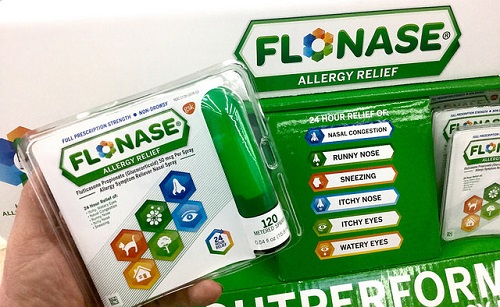Difference between Flonase and Nasonex
Flonase (fluticasone propionate – GlaxoSmithKline LLC) and Nasonex (mometasone furoate – Merck & Co., Inc.) are both glucocorticosteroids, medicines which limit or reduce inflammation, both are delivered via a nasal spray. Flonase and Nasonex are most often prescribed to combat seasonal, such as hayfever, and year-round allergies, such as pet allergies. Additionally, they are also occasionally prescribed to combat nasal polyps and asthma. When sprayed into the nose both can help relieve inflammation and congestion and reduce sneezing. Both are also available as generic medications which use the same compound but not tradename often making them cheaper.
Availability and Price
In the US Flonase is available over the counter whereas Nasonex is prescription only, Flonase is priced at approximately $60 whereas Nasonex is currently priced at approximately $250. In the UK Flonase is classed as a pharmacy medicine whilst similarly to the US Nasonex is prescription only.
Possible Side Effects
Side effects associated with adult Flonase treatment include headaches, nosebleeds, nasal irritation and throat irritation. In children headaches and nasal irritation were not observed as side effects however nosebleeds, nausea, asthma like symptoms and throat irritation were observed.
In a study of adult and adolescent patients Nasonex was associated with headaches, nose bleeds, throat irritation, sinusitis, muscular pain and infection of the upper respiratory tract. As with Flonase in trials in children nausea and vomiting were associated with Nasonex treatment.
As with all corticosteroids issues with hypersensitivity (allergic immune system reaction), immunosuppression (inflammation is important in defence against infection, steroids can suppress this making infection more likely and longer lasting) and growth suppression (in children steroids can limit growth) may occur.
Both Flonase and Nasonex are listed in the US Food and Drug Agencies pregnancy category C “Weigh risks vs benefits”. As research studies demonstrated harmful effects during pregnancy although the work has not been confirmed in humans.
Drug processing
Understanding how a drug is processed is important as off-target, undesired effects can occur. When delivered by nasal spray Flonase was calculated to have a bioavailability of less than 2%, Nasonex was estimated at less than 1% when assaying blood. This means that when delivered correctly both drugs are not readily absorbed by the body and so are very unlikely to generate off-target effects.
Due to the low bioavailability of each elimination studies were performed by direct administration of each drug to the blood. The half-life, time for half of administered drug to be processed, of Flonase was calculated to be 7.8 hours with absorbed drug secreted mainly via feces with a small proportion excreted via urine. Nasonex displayed a decreased half-life, 5.8 hours, but a similar excretory profile. Both of these results are favourable and suggest that both are safe even in the case of incorrect delivery.
Recommended Dosage and Delivery
Both Flonase and Nasonex recommend two sprays (each spray 50 µg) in each nostril once daily, giving a total daily dose of 200 µg per day. For children (Flonase 4-12 years old, Nasonex 2-12 years old) a single spray in each nostril once daily is recommended giving a total daily dose of 100 µg per day.
Care must be taken during administration as there was some evidence that the delicate tissues present in the nose could be damaged, meaning the drug would be delivered into the bloodstream rather that the airways. Although as discussed above the dosages of drugs delivered are still safe if this occurs.
Clinical Trials
Thirteen controlled trials were conducted in the US in adult and child patients to investigate the efficacy of Flonase use in patients with seasonal or year-round allergies. The trials included 2,633 adults (1,439 males and 1,194 females) with an average age of 37 and 440 adolescents (405 males and 35 females) with an average age of 14. Participants were evaluated using the total nasal symptom scores (TNSS) which includes rhinorrhea (runny nose), nasal obstruction, sneezing and nasal itching after treatment with Flonase or a placebo for 2 to 24 weeks. Participants treated with Flonase reported significantly greater decreases in TNSS compared to those receiving placebo.
A total of eighteen similar trials of Nasnonex have been performed in the US. The trials included 3,210 adults (1,757 males and 1,453 females) with an age range of 17 to 85 and 283 adolescents (182 males and 101 females) with an age range of 12 to 16 years. Participants treated with Nasonex reported significantly greater decreases in TNSS compared to those receiving placebo.
No trial directly comparing Flonase to Nasonex has currently been performed.
- Difference between vertebrates and invertebrates - July 14, 2016
- Difference between Flonase and Nasonex - June 23, 2016
Search DifferenceBetween.net :
1 Comment
Leave a Response
References :
[0]U.S. Food and Drug Administration, Drugs@FDA, FLONASE (NDA) 020121, GLAXOSMITHKLINE, First Approved 10/19/1994
[1]U.S. Food and Drug Administration, Drugs@FDA, NASONEX (NDA) 020762, MERCK SHARP DOHME, First Approved 10/19/1997
[2]https://www.flickr.com/photos/jeepersmedia/26714579926


Very informative. However, reason for large price variance remains questionable